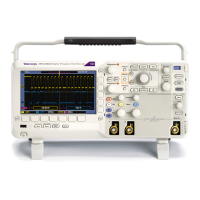Oscilloscope Reference Autoset considerations
Autoset considerations
Autoset acquires samples from the input signal and attempts to take the following actions based on the
input data:
Evaluates the amplitude range of the input signals and sets the size and vertical offset of the vertical
acquisition window to acquire the signal with good resolution, but without clipping.
Sets the trigger to the approximate midlevel of the signal being Autoset and switches to edge trigger
mode.
Evaluates the signal transitions and sets the horizontal scale to produce a waveform display of 2 or
3 cycles of the input s ignal.
Sometimes Autoset cannot produce a correct display due to the nature of the input signal. If so, you may
have to adjust the scale, trigger, a nd acquisition controls manually. The following are some conditions
that can
cause Autoset to fail:
No signal present
Signals with extreme or variable duty cycles
Signals with multiple or unstable signal periods
Signals with too low amplitude
No recognizable trigger signal
Sign
als with a frequency < 20 Hz
Signals with a frequency above the bandwidth of the instrument
What do you want to do next?
Learn about adjusting the horizontal scale. (see page 833)
Learn about trigger setup. (see page 385)
Learn about horizontal acquisition controls. (see page 61)
A
cquisition hardware
Before a signal can be acquired, it must pass throug h the input channel where it is scaled and digitized.
Each channel has a dedicated input amplifier and digitizer, as shown in the next figure; each channel can
produce a stream of digital data from which the instrument extracts waveform records.
Refer to Signal Connection
(see page 689) for further description of scaling, positioning, and DC offsetting
of channels.
DSA/DPO70000D, MSO/DPO/DSA70000C, DPO7000C, and MSO/DPO5000 Series 687

